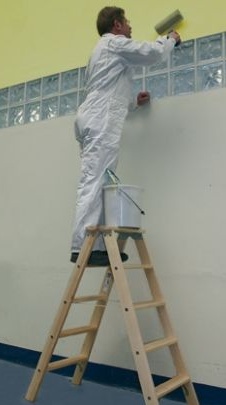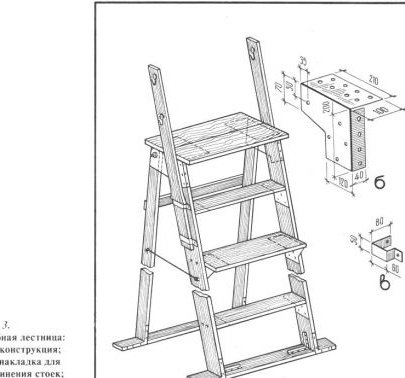Famous staircases for gardening are usually somewhat uncomfortable, primarily because of the lack of a working platform at the top and the inability to place a bucket or basket there. I made and use country stairs without these flaws (Fig. 3).
Two front racks (boards) of the stairs have a section of 40x120 mm, and two rear racks (boards) that ensure the stability of the stairs are 40x80 mm. In the upper part of the front struts, two-layer linings of galvanized iron 0.5 mm thick are attached with nails or screws (Fig. 3.6). In this figure, the bold lines show the places of bending of metal workpieces at an angle of 90 ° for the left side of the country staircase (for the right side of the workpiece they are bent in the opposite direction): A platform is mounted on top of the overlays either from two boards 600 mm long and 30x165 mm cross-section, or from thick plywood.
Between the front struts with a step of 300 mm, steps are made of 30 mm docokoltina, and the lining is also used as supports for them - corners made of sheet iron (their shape is clear even without a drawing). Since the steps have different widths (they alternate as follows: narrow - wide), the wide 200 mm steps extend beyond the racks (respectively, and the covers for the latter also extend beyond the racks).
To increase the rigidity of the country-garden stairs, nails are hammered into the ends of the step boards through the racks. To increase the stability of the stairs when installing it on soft ground, base boards are nailed to the uprights from below. To prevent the ladder from swinging left and right under load, the joints of the racks and bases are reinforced with metal corners. Similar corners for the front pillars are welded from a steel corner with shelves 40 mm wide, the corners for the rear pillars are cut from sheet steel 4 mm thick. For even greater structural rigidity, you can additionally install the corners under the upper platform or sew the mounting boards crosswise from the back of the front struts. The rear struts are additionally interconnected by a cross member.
To fix the stairs in the working position, hooks bent from a steel bar with a diameter of 8 ... 10 mm are used.The hooks on the front struts are fixed with U-shaped brackets made of steel wire with a diameter of 4 mm. To the rear racks nailed for hook loops of the same wire. Handrails mounted on the front racks using galvanized sheet holders (Fig. 3, c) have hooks for hanging tool bags, fruit buckets, etc.
Yes, I completely forgot to say that the rear pillars are attached to the upper plates (see Fig. 3.6) using a steel rod with a thread at the ends. So after using the cottage-garden staircase, I remove the slats - handrails, unscrew the nuts on the connecting rod, disassemble the cottage ladder and store it under a canopy. To increase durability, it is advisable to cover the wooden parts of the stairs twice with drying oil.
The height of the staircase above the ground is 2300 mm with the length of the racks 2500 and 2350 mm (the front racks are longer); the distance between the supports is 1250 mm. The ladder easily moves from place to place by one person. It is stable, safe, easy to use and during storage, which is proved by several years of its operation.


